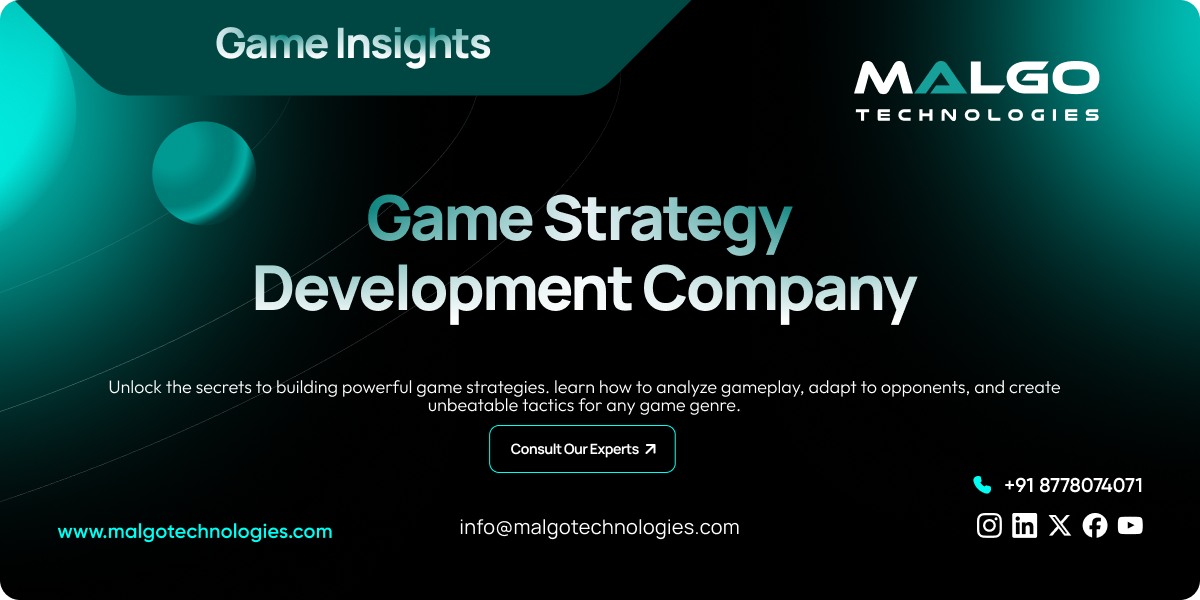Introduction
While stunning visuals and compelling storylines grab attention, it’s the gameplay experience that truly captivates players, and that’s where strategy takes center stage. A well designed game strategy does more than guide gameplay; it transforms how players engage, learn, and immerse themselves in the world you’ve created.
Malgo is a leading game development company that understands the power of strategy in crafting unforgettable gaming experiences. Their focus on thoughtful game mechanics and smart design ensures players don’t just play, they think, plan, and evolve with every move.
Whether it's a fast paced action game or a chill puzzle app, strategic depth is what keeps users coming back for more. It fuels excitement, sharpens decision making, and adds layers of meaning to every interaction. Because in the end, the real magic of gaming isn’t just pressing buttons, it’s making every move count.
What is Game Strategy Development?
Game strategy development is the creative and analytical process of designing systems that influence how players think, act, and progress within a game. It focuses on crafting structured paths that balance challenge, growth, and competition to keep players engaged.
Whether it’s a solo adventure or a competitive multiplayer experience, well-thought-out strategies enhance replayability and player satisfaction. Developers aim to build decision-making layers that test skills, encourage exploration, and reward smart choices.
Strategic depth isn’t just about difficulty it’s about offering meaningful options that make every playthrough unique. This process is essential for driving long-term engagement, building player loyalty, and creating memorable gaming experiences that stand out in today’s highly competitive gaming market.
Key Features of a Game Strategy Development
A good strategy system is never accidental. It incorporates several key features that align with the game’s goals and audience.
Balanced mechanics: No single path should dominate. Players must be able to experiment and succeed using different methods.
Progressive difficulty: As players improve, the game should scale in challenge to match their development.
Feedback systems: Immediate and long-term feedback scores, visual cues, rewards help guide player decisions.
Replay potential: The strategy should encourage multiple approaches, giving players reasons to return and try new tactics.
Risk vs reward: Strategic options must require thoughtful trade-offs. A low-risk move may offer small rewards, while bold choices can lead to big gains or major losses.
How Our Game Strategy Development Stands Out
Our focus is on clarity, balance, and results. Every element of strategy is crafted with the end-user in mind.
Start testing gameplay in the early stages and continue frequently to refine mechanics before diving into full-scale production.
Player psychology research to create challenges that feel rewarding rather than frustrating.
Flexibility for different play styles, ensuring that both casual players and hardcore strategists find satisfaction.
Data-driven iteration, using user behavior to fine-tune strategies in post-launch phases.
The difference lies in the groundwork. Before coding even begins, we build models of how players will interact with the system.
Core Components of a Strong Game Strategy
Whether building for console, mobile, or PC, every strategic framework is built on a few critical components:
Objective clarity
Players should always know what they’re aiming for. When goals aren't clearly defined, users often feel lost and uncertain about what to do next.
Dynamic systems
Strategy must evolve based on player choices. Static systems lead to repetitive gameplay.
Resource management
This could involve health, money, units, energy, or time. Effectively handling these elements is essential to building a successful and well-rounded strategy.
Opposition
There should always be forces working against the player AI, environmental constraints, or competing players.
Decision weight
Every choice should matter. Whether it's building a unit or selecting a quest path, the game should reflect consequences.
Step-by-Step: How to Develop a Game Strategy
Creating strategy from scratch is both creative and analytical.
Define the Goal
What does success look like in the game? Whether it’s defeating a boss, solving a mystery, or building a kingdom, this must be clear.
Map the Player Journey
Understand how players will move from start to finish. What skills or knowledge should they gain along the way?
Design the Mechanics
Establish how the player interacts with the game world. Define rules, tools, and limitations.
Integrate Choice and Consequence
Design adaptable systems where every choice shapes a distinct result, empowering dynamic and personalized experiences. This is what gives the game depth.
Balance for Fairness
Test your systems to ensure no one tactic dominates. Let every strategy have its place.
Playtest with Target Audiences
Watch how actual players engage with your strategy. What works? What feels unfair or confusing?
Refine Based on Data
Use feedback and performance metrics to tune difficulty curves and resource distribution.
Tools and Frameworks for Game Strategy Development
The process of designing and refining strategy is supported by various tools and frameworks, such as:
Unity & Unreal Engine: These engines offer flexible scripting for building strategic gameplay loops.
Miro & Figma: Useful for flow charting systems before development begins.
Excel or Google Sheets: Spreadsheets help in balancing values attack points, currency systems, time allocations.
PlaytestCloud captures live player feedback, while GameAnalytics monitors in-game behavior to boost performance and engagement.
Frameworks such as MDA (Mechanics, Dynamics, Aesthetics) are also commonly used to align gameplay mechanics with player emotions and behaviors.
The Biggest Design Traps in Strategy Games And How to Avoid Them
Complexity with clarity: A well-designed system can be rich in features without overwhelming the user.If players don’t understand how something works, they won’t use it.
Imbalanced power curves: One overpowered strategy can make all others irrelevant.
Ignoring edge cases: Players will always find the shortest route or exploit test for that.
Under-testing: Skipping user testing can result in broken or boring strategies.
Misleading cues: If the game implies one thing but rewards another, it causes frustration.
Real-World Examples of Effective Game Strategies
StarCraft II
One of the most competitive games in history, StarCraft II balances three distinct races with unique strengths and weaknesses. Success depends on understanding resource timing, positioning, and counterplay.
XCOM: Enemy Unknown
This turn-based strategy title is praised for its permadeath system and fog of war. Every decision carries weight, and even small choices can have long-term impact.
Into the Breach
Every action has a visible consequence. This transparency makes players feel fully responsible for the outcome, increasing engagement and satisfaction.
These examples show how thoughtful strategy can elevate a game beyond its mechanics.
Why Choose Malgo for Game Strategy Development?
At Malgo, we approach strategy with intent and precision.
Player-focused planning: We study how different demographics play and think, so our strategies feel intuitive and engaging.
Flexible design process: Our developers work closely with designers and analysts to keep gameplay smooth and balanced.
Transparent collaboration: We involve stakeholders throughout the process to align vision and execution.
Iteration without compromise: We improve continuously, but always protect the core experience.
Conclusion
Good strategy makes great games unforgettable. From pacing and choice making to challenge and replayability, strategy shapes the player experience. Done well, it adds depth, excitement, and satisfaction to every session.
Whether you're starting a new game or improving an existing one, thoughtful strategy design can make all the difference. It's not about tricks or gimmicks it's about meaningful structure and responsive systems that respect the player.
Want to build a game with strategy that keeps players thinking, experimenting, and coming back for more? Let’s talk. Contact Malgo today and shape your next winning experience.
Frequently Asked Questions
Game strategy development is the process of designing, analyzing, and refining strategic approaches to succeed in a game, whether digital, tabletop, or physical. It involves tactics, player psychology, and mechanics optimization.
Strategy adds depth, replayability, and challenge to games. It enhances user engagement and provides a framework for balanced gameplay, leading to better player retention and satisfaction.
- Understand core mechanics
- Study player behavior
- Analyze game rules and win conditions
- Test and iterate tactics continuously
- Clear objectives
- Resource management
- Tactical decision-making
- Risk vs. reward analysis
- Adaptability to different scenarios
- Unity & Unreal Engine (for game design)
- Excel or Notion (for planning)
- Playtesting platforms
- AI simulators for strategy refinement


